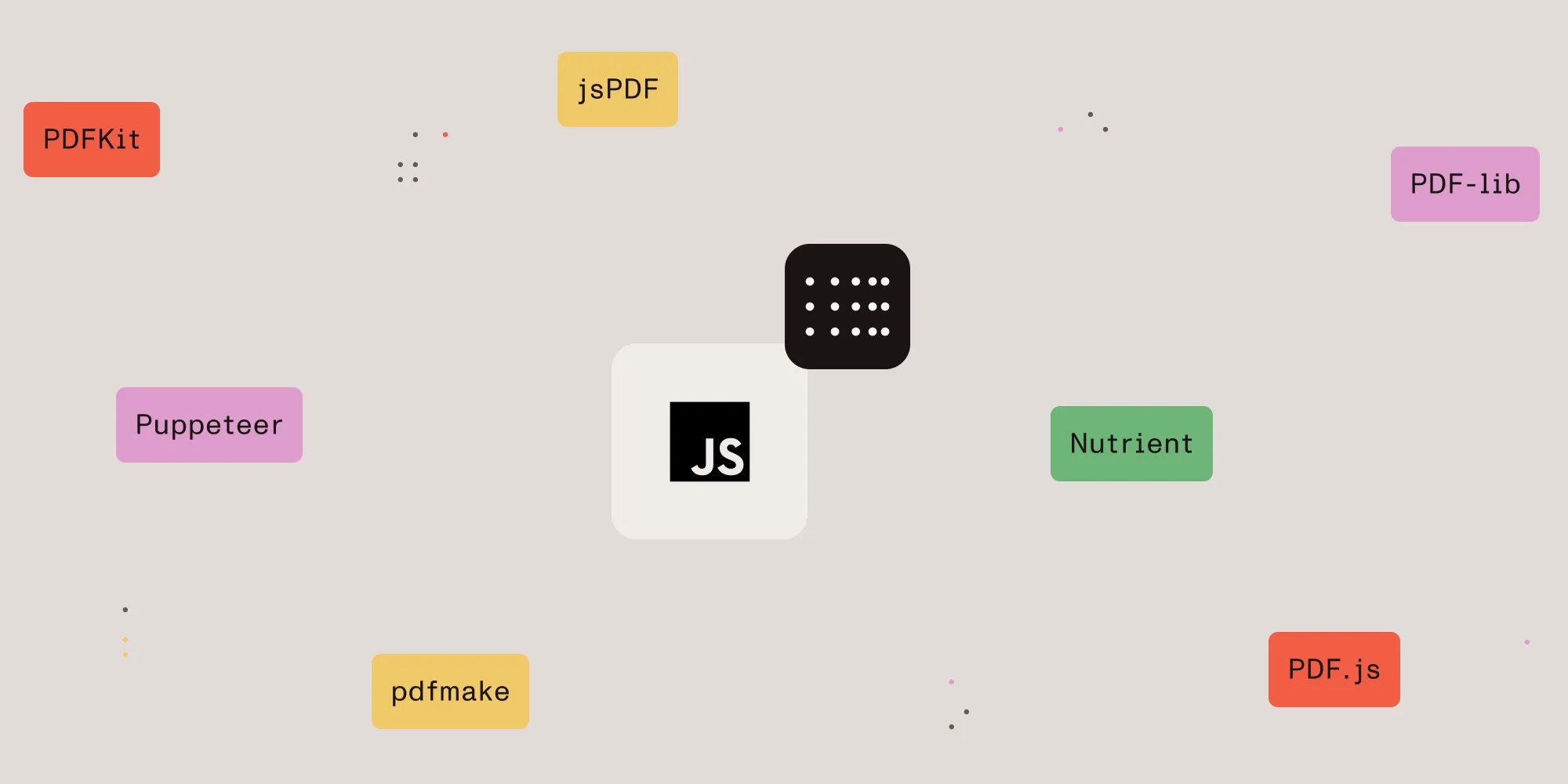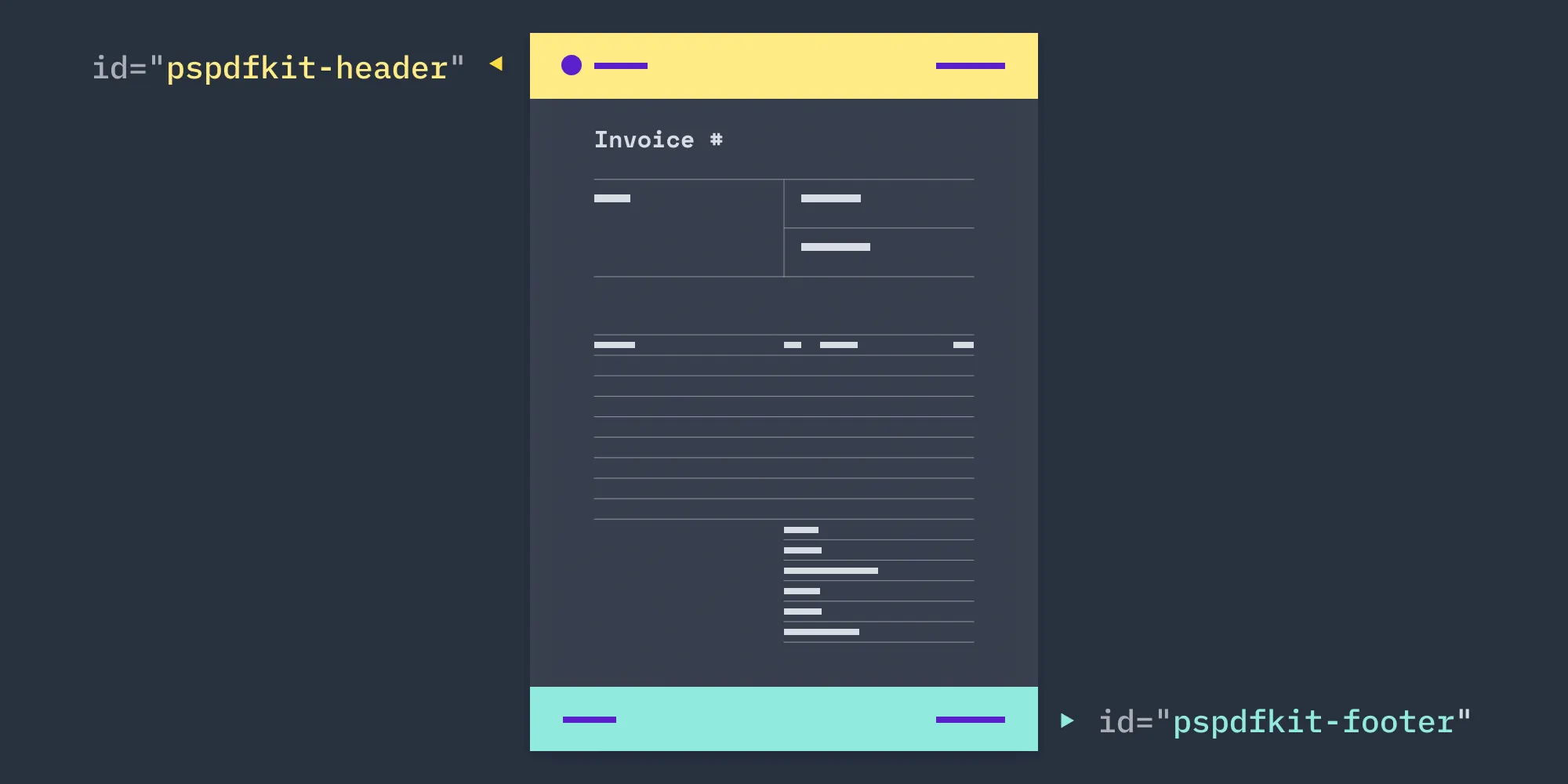Best PDF generator APIs for your needs

This comprehensive guide compares the six best PDF generator APIs in 2024, covering key selection criteria like accuracy, security, reliability, and pricing models. The post explores common use cases — including invoice automation, report generation, and document workflows — while providing detailed breakdowns of top APIs like Nutrient DWS API, PDFMonkey, and Anvil.
In this post, we’ll provide a detailed breakdown of the most popular PDF generator APIs. To help you pick the best one for your use case, we’ll cover:
- What a PDF generator API is
- Common use cases
- The selection criteria for PDF generator APIs
- How pricing models are set up
- The pros and cons of the most popular PDF generator APIs
What is a PDF generator API?
A PDF generator API is a hosted service where you send structured data via an API call to a server and receive a PDF document back.
Traditionally, if you wanted your application to generate a PDF, you’d have to set up a server and integrate a PDF generation library on that server. Using a PDF generator API simplifies that process. Now, you just need to add a small piece of code to your application to start generating PDFs.
Not only is using an API to generate PDFs easier to set up initially; it’s also easier to maintain. You won’t have to deal with server management issues (keeping it secure, keeping the operating system up to date, fixing breakdowns, upgrading it to keep it fast, etc.) or keeping your PDF generation library updated.
However, foregoing a server and using a PDF generation API isn’t always the best solution. In situations where you want to control your data completely, it makes more sense to manage your own server. You can use a self-hosted Document Engine that you add on your server to do this.
To sum up: If you want a simple, convenient way to generate PDFs for your application, using an API is the perfect solution. If you’re looking for total control over your data, or if you have a specific use case in mind, using your server may serve your needs better.
Benefits of using a PDF generation API
Using a PDF generation API can bring numerous benefits to your business. Below are some of the most significant advantages.
Increased efficiency — Automate the process of generating PDF documents, saving time and resources. By integrating a PDF generation API, you can streamline workflows and reduce manual effort, allowing your team to focus on more critical tasks.
Improved accuracy — Reduce errors and inconsistencies in your PDF documents with automated generation. Manual document creation can lead to mistakes, but a PDF generation API ensures your documents are accurate and consistent every time.
Enhanced customization — Easily create custom PDF templates and merge data to generate personalized documents. Whether you need to create invoices, reports, or certificates, a PDF generation API allows you to design stunning PDF documents that reflect your brand.
Scalability — Handle large volumes of PDF generation with ease, without compromising on performance. As your business grows, a PDF generation API can scale with you, ensuring you can generate PDF documents efficiently, regardless of volume.
Cost savings — Reduce costs associated with manual document generation and maintenance. By automating the process, you’ll save on labor costs and minimize the need for additional software or hardware.
Common use cases for PDF generator APIs
The following section outlines a few standard use cases for when a PDF generator API might practical or necessary.
Automating invoice generation
One of the most common PDF generation API use cases we see is from customers who need to automate their customers’ invoicing processes. By integrating an API into your workflow, you can start passing billing or purchase information into an invoice template to automatically generate a PDF invoice. This can significantly speed up the process and reduce the risk of human error.
Streamlining report generation
If you have an application that generates custom reports for your users, you likely also need to provide them with PDF versions of those reports. A PDF generation API lets you streamline this process by pushing data into a report template and creating the PDF report. For multiple reports, you can merge them into a consolidated document.
Creating financial and legal documents
Within financial and legal software, data is often captured in a custom workflow. Users are regularly required to fill out lengthy loan applications, insurance contracts, or homeownership agreements, and they’ll need copies of the completed contracts for their records. With a PDF generation API, you can push a user’s data into standardized templates and create a PDF document that consolidates all their information.
Enhancing human resources documentation
By integrating your HR management and payroll software with a PDF generation API, you’ll be able to pull data directly from your databases and populate documents automatically. Easily generate payslips, employment contracts, employee reviews, employment policies, and other important documents.
Logistics
Documentation is at the heart of logistics operations. Bills of lading, consignment notes, packing lists, various certificates of origins, and invoices all need to be prepared, printed out, and shared with authorities and recipients of goods globally. This process can be simplified by integrating a PDF generation API with logistics software, enabling all of this documentation to be generated automatically.
Education
An API can help you generate a certificate with your students’ names and completion dates for online courses or training programs. It can be integrated with a learning management system (LMS) to support dynamically generating academic transcripts, report cards, program outlines, application forms, and more.
Key selection criteria for PDF generator APIs
There are a few factors to consider when choosing a PDF generator API, which we’ve outlined below.
Evaluating API accuracy
One of the most critical factors when evaluating PDF generation APIs is accuracy. In this context, accuracy is all about how closely the generated document matches your original template. When you generate a document, does the API match the fonts defined in your template? Are images like your logo, product photos, and watermarks rendered correctly in the final PDF?
Assessing reliability and uptime
When integrating an API, reliability means your service isn’t interrupted. To evaluate reliability, focus on the following factors:
- Test the API’s ability to process large documents.
- Track and record any service disruptions or downtime.
- Check if the provider offers a service-level agreement (SLA) for guaranteed uptime.
- Monitor latency, or how quickly the API responds to requests.
Security considerations
When integrating a hosted API solution into your software or application, there are several security factors to consider:
Encryption — Confirm that the API provider encrypts your data in transit. Encrypting data in transit protects your data if communications are intercepted when data moves between your application and the API service used for generating your PDF.
Storing data — Investigate what happens to your data once you’ve passed it to the API. Does the API provider immediately delete that data from its servers, or does it purge it after a set time period?
Security certifications — Determine if the API provider is investing in security certifications. The most common include SOC, HIPAA, and GDPR certification.
The most secure PDF generation option is a self-hosted option. At Nutrient, we offer a PDF processor you can host in your own environment.
Features
When it comes to evaluating features in a PDF generation API, there are two questions worth considering:
- Does the API offer the features I need to accomplish my tasks?
- Will this API meet any additional document processing capabilities I might have in the future?
Common PDF generator features
PDF generation APIs generally fall into two categories — those that convert HTML to PDF, and those that use templates to generate the PDF. Here are some of the most common features offered by these APIs:
- Adding a repeating header and footer
- Out-of-the-box templates
- The ability to convert from URLs
- HTML-to-PDF conversion
- Drag-and-drop editors
Future-proof APIs
If you plan to provide additional PDF processing capabilities in the future, consider finding an API that offers a wider set of features. Working with one API solution for all document processing will often save setup time and have a total lower cost. The most popular document processing API features are:
- eSigning API — Adding electronic signatures to PDFs
- OCR — Extracting text from an image and converting to PDF
- Editing — Deleting, merging, adding, and rotating PDF pages
- Conversion — Converting MS Office and image files to PDF
Key features to look for in a PDF generation API
When selecting a PDF generation API, consider the following key features:
Template support — Look for an API that supports reusable PDF templates and allows for easy customization. This feature enables you to create consistent and professional-looking documents quickly.
Data merge — Ensure the API can merge JSON data with templates to generate dynamic PDF documents. This capability is crucial for creating personalized documents that pull data from various sources.
PDF conversion— Choose an API that supports PDF conversion from various file formats, such as HTML, images, and more. This flexibility allows you to convert different types of content into PDF files seamlessly.
Security — Opt for an API that prioritizes data security and provides features like encryption and access controls. Protecting sensitive information is essential, especially when dealing with financial or legal documents.
Integration — Select an API with easy integration options, such as REST APIs, SDKs, and tutorials. A well-documented API with robust integration options ensures a smooth implementation process.
Pricing models for PDF generator APIs
The most common PDF generation API packages start between 500 and 2,500 documents but can range from 50 documents all the way up to 1,000,000. When exploring different pricing options, you’ll typically find the following:
- Free tier — Provides you with a small number of free API calls per month.
- Monthly/annual subscription — Provides several packages with varying amounts of API calls that are replenished every month.
- Pay-as-you-go option — Lets you buy a set number of API calls that you can use over a specified time period.
Document-based pricing
This is the simplest payment model. You’ll be charged per document processed and won’t have to consider file size, datasets being merged, or different API actions being called.
Credits consumed by file size
Some API vendors require more credits for processing large files. For example, every megabyte of data could consume one credit. In this scenario, it can be hard to predict how many credits you need, because you have to understand the size of documents you’re processing every month.
Credits consumed by dataset requests
Some API providers will charge you for each dataset contained in your request. If you plan on using an API with this model, it’s crucial to understand how many datasets you’ll be pulling data from to accurately calculate pricing.
Credits consumed by API action
Some solutions consume a credit each time an API action is performed. If you’re only using the API to perform one action per document, this pricing is straightforward. However, if you have a workflow with multiple processing actions, it’ll be harder to predict the total cost of the solution. For example, if your workflow involves generating a PDF and then overlaying it with a watermark, you’ll need to spend two credits.
Paying for processing time
With this model, you purchase processing time per month. If each demand you make takes a minute to process, you’ll need to purchase 100 minutes to process 100 documents in a month. This allows API vendors to limit use and charge more for larger files and more complex processes. However, this method isn’t that great for the user, as it’s difficult to estimate how much processing time you’ll need.
Top 6 best PDF generator APIs
Now that you have an overview of what a PDF generator API is, how it’s used, how to choose one, and how costs are determined, we’ve provided an overview of the six best PDF generator APIs available.
Nutrient DWS API

Since 2011, we at Nutrient have been working with the PDF specification and have developed one of the most comprehensive PDF SDKs(opens in a new tab) available on the market. During that time, we’ve been able to work with clients like Disney, IBM, UBS, and Dropbox to help them improve how their users work with PDF documents.
[Nutrient DWS API][api] is our first hosted product — an API that offers more than 30 document processing tools (with many more tools planned).
Our PDF Generator API gives you the ability to generate PDF files from HTML templates. You can style the CSS, add unique images and fonts, and persist your headers and footers across multiple pages. Additionally, Nutrient DWS API offers:
- Support for Postman collections
- Language-specific documentation with sample code
- Support for custom CSS and HTML
- Support for customizing headers and footers
In addition to generating PDFs, one of the key benefits of Nutrient DWS API is that you can combine additional document processing tools in your PDF generation workflow, including:
- PDF editing
- OCR
- Watermarking
- Document conversion (supports more than 10 file types)
Documents supported
- DOCS
- DOC
- XLSX
- XLS
- PPTX
- PPT
- PNG
- JPG
- TIFF
- HTML
Pricing
Nutrient has a simple pricing policy, which is based strictly on the number of documents you need to generate. You’re not limited by document size or the number of datasets requested. Additionally, you get an unlimited number of API actions for each document. All API actions — such as conversion, OCR, watermarking, flattening, merging, splitting, and editing — spend just one credit when combined in a single document. This is helpful when you’re building complex applications and workflows. Many other vendors charge based on the number of actions, which results in workflows being both difficult to develop and costly.
Nutrient offers multiple plans with subscription-based pricing, allowing a varying number of documents to be processed. You can learn more about the pricing on our website.
If you want to test it out, you can create a free account(opens in a new tab) that comes with 100 free credits. Different operations on a document consume different amounts of credits, so the number of PDF documents you can generate may vary.
PDF Generator API

PDF Generator API is one of the most popular solutions and offers a flexible REST API and template editor you can use to generate PDF documents. You first need to create a template, and then you need to pass the template ID and the JSON data through the API to generate the PDF.
Documents supported
- JSON
Pricing
PDF Generator API has five different pricing plans that vary in the amount of documents you’ll be able to generate. It charges its users by the number of “merges” per document generated. What this means is that if you pull data from three different sources to generate your PDF, you’ll be charged for three “merges” for generating that document, instead of just one.
APITemplate.io

APITemplate.io is a flexible template editor you can use to generate PDFs. It has an online editor that accepts HTML, Markdown, and WYSIWYG and converts these formats into PDF.
You can also integrate this tool into Zapier, n8n, and Integromat. The best feature of this tool is that you can preview the live PDF before publishing it. Additionally, APITemplate.io supports headers and footers with page metadata like the page number and the total number of pages.
Documents supported
- HTML
- Markdown
- WYSIWYG
Pricing
APITemplate.io has a simple pricing structure with three pricing tiers. Each tier increases the number of PDFs you can generate and the number of templates you can use.
PDFMonkey

PDFMonkey is a simple REST API that takes HTML or JSON data to generate a PDF. You can also load external resources — like images, CSS, and JavaScript — in a template to generate the PDF. The API is straightforward and easy to use.
Documents supported
- HTML
- JSON
Pricing
PDFMonkey has a simple pricing model. The free tier subscription allows you to generate 300 PDFs per month. In addition, there are three paid tiers that increase the number of PDFs you can generate. There aren’t any catches or complex pricing strategies. Customers who pay annually also get a 10 percent discount.
Anvil PDF Generation API

This is another very simple API that takes HTML and CSS or Markdown to generate the PDF. You just need to pass the HTML and CSS as a string, and it returns the PDF. It also has a Postman collection that you can integrate into your Postman.
The documentation is nicely written and has code for rendering PDFs in React and Vue.js. You can also use Anvil’s Node client library to encrypt the data payloads with your public key.
Documents supported
- HTML and CSS
- Markdown
Pricing
Anvil doesn’t have monthly plans for its PDF generation API; you’re charged when you make a PDF generation request.
Paperplane

The way Paperplane generates PDFs is different to other APIs. You need to have an AWS S3 bucket ready with upload permissions. You then have to put the API keys of your AWS account under the destinations, and only then is it ready to convert. After this, you can download the PDF directly or have it generated and uploaded to your S3 bucket.
Documents supported
- HTML
Pricing
Paperplane has no free plan, but it offers a 14-day trial, which should be enough to test the product’s capabilities. There are fixed-price plans, plus overage charges. Each of the packages has varying overage charges (meaning how much you have to pay for each PDF over the limit). It’s also important to note that the Basic package doesn’t include the company’s 99.8 percent uptime guarantee.
Choosing the best PDF generation API for your business
When choosing a PDF generation API, consider the following factors:
Business needs — Assess your business requirements and choose an API that meets your specific needs. Whether you need to generate invoices, reports, or certificates, ensure the API can handle your use cases.
Scalability — Select an API that can handle your expected volume of PDF generation. As your business grows, the API should be able to scale with you, ensuring consistent performance.
Customization — Opt for an API that offers flexible customization options to meet your branding and design requirements. The ability to create custom templates and styles is crucial for maintaining a professional appearance.
Security — Prioritize data security and choose an API that provides robust security features. Look for encryption, access controls, and compliance with industry standards to protect your data.
Support — Look for an API with reliable customer support and resources. Good documentation, tutorials, and responsive support can make a significant difference in your implementation experience.
Final words
The best PDF generator for you depends entirely on your project’s requirements. While you should never make compromises in terms of security and reliability that an API offers, you can be flexible with other factors and features.
If you only need to generate PDFs, and you don’t think your needs will expand in the future, then it’s a good idea to go with the most affordable solution. However, if you have — or predict having — more complex workflows, then the feature list becomes the crucial factor when selecting the right API.
If you want to test Nutrient’s PDF generation API, you can create a free account(opens in a new tab). It comes with 100 free credits and has access to all the [Nutrient DWS API tools][api], such as watermarking, PDF editing, OCR, and much more.
FAQ
What is a PDF generator API?
A PDF generator API is a hosted service that allows you to create PDF documents by sending structured data to an API, which then returns a PDF file.
What are common use cases for PDF generator APIs?
Common use cases include automating invoice generation, generating reports, creating financial and legal documents, and producing educational materials.
How do I choose the right PDF generator API?
Consider factors like accuracy, reliability, security, feature set, and pricing models to ensure the API meets your project’s needs and budget.
What features should I look for in a PDF generator API?
Look for high-quality rendering, customizable templates, support for dynamic data, and additional functionalities like annotations and form handling.
Can PDF generator APIs be integrated with web applications?
Yes, most PDF generator APIs offer SDKs or RESTful interfaces that facilitate integration with web applications for seamless PDF creation and management.
What are the common challenges with PDF generator APIs?
Challenges include handling large documents, ensuring compatibility with various file formats, and managing API usage limits or costs.







